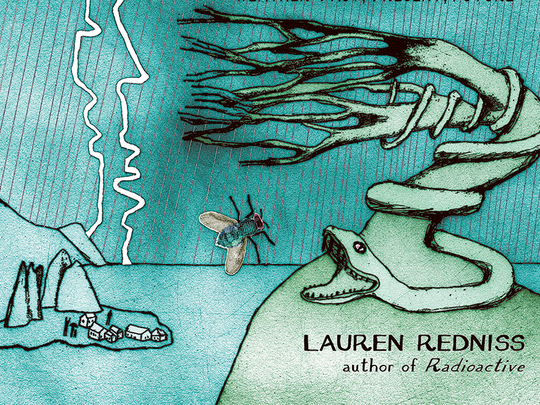
Thunder and Lightning: Weather Past, Present, Future
By Lauren Redniss
Illustrated. 261 pages. $35
To think: there was a time when weather was safe! As a noncontroversial counterpoint to dinner-table hot buttons such as religion and politics, weather has probably played analgesic for generations of families. And then, of course, weather turned into climate, which combined all of the above, and suddenly there was nothing less safe in the world. As Lauren Redniss writes in Thunder and Lightning: Weather Past, Present, Future, weather is the state of the atmosphere, whereas climate describes prevailing weather patterns on a larger scale. “But changes to climate, by definition, mean changes in the weather.”
Redniss has been called a “graphic biographer”. Although at first glance they bear some resemblance to graphic novels, her two previous books — Century Girl: 100 Years in the Life of Doris Eaton Travis, Last Living Star of the Ziegfeld Follies and Radioactive: Marie and Pierre Curie, a Tale of Love and Fallout (a finalist for the National Book Award) — resist easy categorisation. Each is a highly particular and visually idiosyncratic examination of a subject, combining illustration, reportage, history, storytelling. Redniss illustrated Radioactive with cyanotype prints.
Thunder and Lightning incorporates the processes of photogravure and photopolymer. In the “Notes” section, Redniss explains that she was inspired by an 18th-century watercolour of a flamingo by the naturalist Mark Catesby, and a later botanical engraving of a cowslip by the artist P. Henderson. “It was to this tradition that I hoped to pay homage with my choice of medium. Catesby’s flamingo and Henderson’s cowslip capture a certain feeling — a sensation of strangeness, wonder, terror — that we experience in the presence of nature, most powerfully perhaps when encountering the forces of the elements: a howling wind, a thunderstorm, the beating sun.” The font she designed for the book is called Qaneq LR, from an Inuit word for falling snow.
Redniss is not averse to whimsy: the wilfully melodramatic titles, the colours and fonts, the attention to style. It’s almost as if she’s challenging the reader to spend time and effort. Physically large and heavy, Thunder and Lightning resists portability. Qaneq LR is as legible as a “Family Circus” caption, but Redniss’s text is dense, and reading it demands vigilance. Colours change from chapter to chapter and page to page, evoking snow, ice, smog. In aggregate, the effect can be magical. We read the words of fogbound sea captains on grey-shaded pages from which only a few words at a time emerge: “In the fog we’re tense. Your senses are honed. You’re waiting and you’re looking.” Then there’s the sweeping range of text-free images that compose the “Sky” chapter, and the bleak landscapes that accompany accounts of snow blindness. These, as Redniss says, do capture certain feelings, and evoke them, too.
Chapter headings — “Chaos”, “Cold”, “Rain”, “Wind”, “War”, “Profit”, “Pleasure” — are as varied as their contents. We meet the keeper of a New England cemetery forced to identify errant corpses after Hurricane Irene (“For some people, all we’ll find is bones and pieces”), see Charles and his new princess, Diana, attempting to visit a fogbound Newfoundland. There are historic logs, quotes from climatologists, bits of lore and legend, an interview with the editor of the Farmer’s Almanac. In the chapter titled “Pleasure” — think of the soothing delights of the BBC shipping forecast, or Benjamin Franklin’s nude air baths — Redniss reproduces Craigslist ads that ran during hurricanes, looking for companionship in the storm: “If the hurricane gonna destroy NYC, let’s watch it together.”
It’s not all human interest, of course: there’s a good bit of straight science, much of it in the words of the scientists and experts Redniss interviews. One comes away from Thunder and Lightning with a basic understanding of the workings of pressure systems, snow, “absolute desert”. It would, in fact, serve as an effective — if idiosyncratic — classroom text.
Redniss makes no claims for herself as an expert. She is guide and student, pulling us irresistibly into her interests and connecting the seemingly disparate threads with a combination of authority and enthusiasm. She is a curator: arranging information with a distinct aesthetic and a point of view. In a way, maybe this book is very much of our time — one of those endeavours whose resistance to traditional labels can feel almost insolent. But at the same time, it puts one in mind of those 19th-century tracts — books such as Celia Thaxter’s Among the Isles of Shoals or the travel writing of Isabella Bird — that dealt as much with passion as fact, with lore as documented history, and as a result managed to render landscapes intensely human.
That is what Redniss has done, too: shown us how human beings live with nature — fighting, coexisting, taming, predicting via leech barometer and radar and intuition. How does one connect with other survivors of lightning strikes? How do engineers render the Haj bearable to pilgrims in 37°C temperatures? How does an endurance swimmer battle the easterly winds between Cuba and Florida? As specific as the individual vignettes may be, the questions are global.
In “Cold”, Redniss takes the reader to the Global Seed Vault near the Longyearbyen settlement on Spitsbergen Island. “In the vault, the Soviet Union and Tanganyika, today’s Tanzania, live on. Territorial disputes in the Middle East do not affect the boxes of seeds labelled ‘Palestine’. A large shipment arrived from Syria in the midst of that country’s civil war in 2012. ‘We don’t play politics here,’” the chairman of the Vault’s International Advisory Council says.
But politics can’t be ignored, even when Israel and the Palestinian National Authority are teaming up to fight a fire on Mount Carmel in what Benjamin Netanyahu called “a special type of battle”. And in more didactic chapters with headings such as “War” and “Profit”, Redniss points to centuries of harnessing the weather for God and country: the “Protestant Wind” that helped defeat the Spanish Armada, or the meteorological phenomena that (North Korea’s state news outlets declared) followed the death of Kim Jong-il.
On one question, she is unequivocal: “Scientists agree that we are living in an age of global climate change,” Redniss writes in “Dominion”. “Human activities are transforming the planet. The consequences, scientists contend, include warmer temperatures, extreme events, wildfires, floods and droughts, rising sea levels and species extinction.”
One can imagine, at this point, certain dissenting readers sitting up in alarm, having been beguiled, perhaps, by the personal anecdotes, the colours, the seemingly artless font, the seed bank and shipwrecks. Such a reader might find an approach like this particularly irresponsible, or even dangerous. Certainly, anyone will recognise its power.
At first, the title Thunder and Lightning seems overblown and almost jokingly apocalyptic, evoking as it does Old Testament retribution that would seem to have little in common with the hundreds of highly individual stories that make up the book. Yet by the end, these have coalesced into a narrative: one that is violent. “Weather” is a constant state of warfare between man and nature. The question becomes, who is the common enemy?
–New York Times News Service
Sadie Stein is a writer and contributing editor at The Paris Review.








